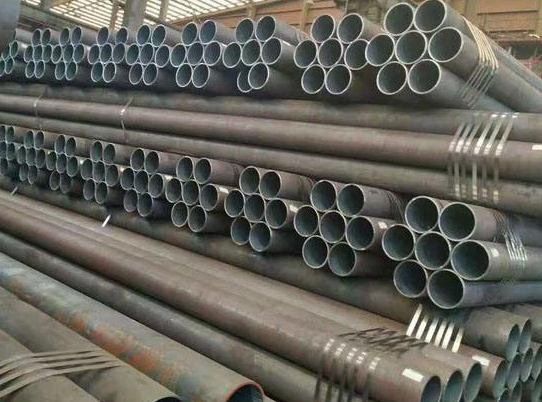
Mechanical Properties Terms for Seamless Pipe
1. The performance index analysis of seamless pipe--plasticity.
Plasticity refers to the ability of metal materials to produce plastic deformation without being damaged under load.

2. Analysis of performance index of seamless pipe--hardness.
Hardness is a measure of the hardness of metal materials. At present, the commonly used method for measuring hardness in production is the indentation hardness method, which uses a certain geometric indenter to press into the surface of the metal material to be tested under a certain load, and the hardness value is determined according to the degree of indentation. Commonly used methods are Brinell hardness (HB), Rockwell hardness (HRA, HRB, HRC) and Vickers hardness (HV) and other methods.3. The performance index analysis of seamless pipe--fatigue.
The strength, plasticity, and hardness discussed above are all indicators of the mechanical properties of metals under static load. In fact, many machine parts are working under cyclic loads, under which conditions the parts will fatigue.
4. Seamless performance index analysis--impact toughness.
The load acting on the machine at a very large speed is called impact load, and the ability of metal to resist damage under impact load is called impact toughness.5. Analysis of the performance index of seamless pipes--strength.
Strength refers to the ability of metal materials to resist damage (excessive plastic deformation or fracture) under static load. Since the load acts in the form of tension, compression, bending, shearing, etc., the strength is also divided into tensile strength, compressive strength, flexural strength, and shear strength. There is often a certain connection between various strengths, and tensile strength is generally used as the basic strength indicator in use.
How to determine the mechanical properties requirements of seamless pipes?
Step 1: First understand the "working conditions" - determine the performance level
|
Working condition characteristics |
Key mechanical concerns |
Examples |
|
Normal temperature and low pressure fluid |
Yield, elongation |
Water and air pipes |
|
Low temperature environment (≤-20°C) |
Low temperature impact toughness KV2 |
LNG pipelines |
|
High-pressure boiler/steam |
High temperature yield and endurance strength |
Main steam pipe 600 ℃ |
|
Dynamic load, fatigue |
Impact energy, fatigue limit |
Marine and wind turbine towers |
|
Corrosion with H₂S/CO₂ |
Upper limit of SSC resistance hardness |
Oil and gas well casing |
Step 2: Lock in the "product standard" - the standard gives all mechanical indicators at one time
|
Use |
Implementation Standards (Latest Version) |
Mandatory mechanics items |
|
High-pressure boiler |
GB/T 5310-2025 |
Rm, ReL, A, KV2, hardness, endurance strength |
|
Petrochemicals |
GB/T 9948-2025 |
Rm, ReL, A, KV2, hardness, grain size |
|
Structural pipes |
GB/T 8162-2018 |
Rm, ReL, A, flattening, flaring |
|
Cryogenic fluid |
GB/T 6479-2013 |
Rm, ReL, A, KV2 (-20 ℃/-40 ℃) |
|
API 5CT 11th Edition |
Rm, ReL, A, hardness, impact (SR16) |
Step 3: Extract “quantitative indicators” – convert standard clauses into tables
Take 15CrMoG (GB/T 5310-2025) for high-pressure boilers as an example:
|
Index |
Required value |
Test temperature |
|
Tensile strength Rm |
440-640 MPa |
Room temperature |
|
Yield strength ReL |
≥235 MPa |
Room temperature |
|
Elongation A |
≥21 % |
Room temperature |
|
Impact absorption energy KV2 |
≥40 J |
20 ℃ |
|
Hardness HBW |
135-195 |
Room temperature |
|
600 ℃ 10⁵ h rupture strength |
≥100 MPa |
600 ℃ |
Step 4: Clarify the “test method” – ensure data traceability
|
Pilot projects |
Method standards |
Sampling location |
Remark |
|
Stretch |
GB/T 228.1-2021 |
1 set each vertically and horizontally |
Gauge length 50 mm |
|
Impact |
GB/T 229-2020 |
Vertical V-notch |
Low temperature requires keeping warm for ≥10 min |
|
Hardness |
GB/T 231.1-2018 |
Three-point average of the outer surface |
Avoid welds |
|
Flattening/flaring |
GB/T 246-2017 |
Pipe end 100 mm |
Structural pipe must be done |
|
Lasting strength |
GB/T 2039-2021 |
3 pieces from the same batch |
High temperature long time test |
Step 5: Add a “verification clause” to the contract
Certificate: EN 10204 3.1/3.2 or GB/T 247 quality assurance certificate.
Lossless: UT (GB/T 5777 C5), ET (GB/T 7735 Class A).
Re-examination: If any indicator fails, double sampling will be conducted for re-examination. If it fails again, the entire batch will be scrapped.
Identification: Spray code "furnace batch number + standard number + impact temperature" for easy traceability.


